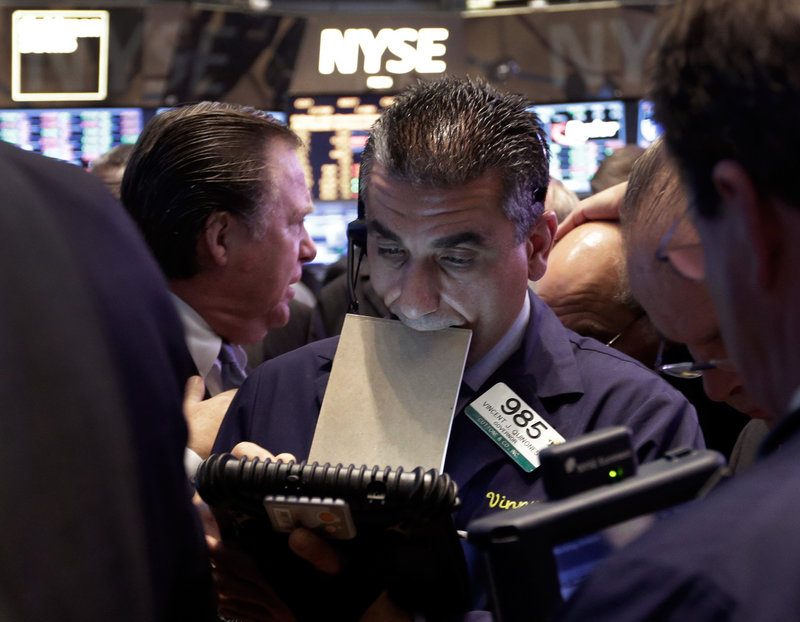NEW YORK – Investors recovered their poise after a shaky start to Wall Street trading that sent stocks sharply lower.
U.S. markets plummeted immediately after the opening bell Thursday, following a global slump prompted partly by an unexpected slowdown in Chinese manufacturing. Concern that the Federal Reserve might ease back on its economic stimulus program sooner than expected also riled investors.
The dip gave investors who missed this year’s stock market surge an opportunity to get into the market, and by midday the market had recouped most of its early loss. Stocks even climbed into positive territory by midday, then ended the day marginally lower.
“Most institutions, most hedge funds and most individuals have watched the market go up without them, so the dips are being bought,” said Jim Russell, regional investment director at U.S. Bank. “There’s a very strong case for U.S. stocks.”
For the most part, the U.S. stock market has been going up steadily since the beginning of the year, with only infrequent declines. Investors’ optimism has been stoked by a pickup in hiring at U.S. employers, a recovery in the housing market and record profits at U.S. corporations.
All that has helped push the Dow up 16.7 percent this year. The Standard & Poor’s 500 index is 15.7 percent higher than at the start of 2013.
On Thursday, however, trading was volatile. The Dow Jones industrial average ended the day just 12.67 points lower, or 0.1 percent, at 15,294.50. It fell as much as 127 points during the first hour of trading.
A sell-off in global markets came after minutes from the latest Fed meeting, released Wednesday afternoon, indicated that several policymakers were leaning toward slowing the central bank’s bond-buying program as early as June if the economy continues to recover.
The central bank is spending $85 billion a month buying bonds. That program has been keeping interest rates low in an effort to encourage borrowing, spending and investing. It’s also meant to encourage investors to buy risky assets such as stocks.
Investors were also unsettled by the report that showed manufacturing in China, the world’s No. 2 economy, unexpectedly shrank this month. HSBC Corp. said the preliminary version of its monthly purchasing managers index had dropped to a seven-month low. China’s booming economy has been a major driver of global growth in recent years and investors worry when they see signs that it’s slowing down.
Stocks fell sharply in Asia on Thursday. Japan’s Nikkei index dropped 7.3 percent after news was released about the slowdown in Chinese manufacturing. The declines extended to Europe, where Germany’s DAX index, which has been at a record high, slid 2.1 percent.
The sell-off looked set to continue when trading opened in New York, but the market quickly hit bottom and reversed course.
Some investors also reevaluated the concern about the Fed easing, or tapering, its economic stimulus program.
Any pullback of the Fed’s stimulus should be seen as a positive signal because it would mean that the U.S. economy is getting stronger, said Joe Quinlan, chief market strategist at U.S. Trust.
“When the Fed starts to taper, the fundamentals of the U.S. economy have improved even further than we have already seen,” Quinlan said. “The Fed tapering is actually a good story for U.S. equities and the economy.”
Encouraging news about the U.S. economy also helped the case for stock market bulls Thursday.
Sales of new homes rose in April to the second-highest level since the summer of 2008, the Commerce Department reported Thursday. Also, the median price for a new home hit a record high, another sign that housing is recovering.
There was good news on the labor market, too.
The number of Americans applying for unemployment benefits fell 23,000 last week to 340,000, a level consistent with solid job growth, the Labor Department said. That suggests employers are laying off fewer workers. The decline in claims has coincided with steady job growth over the past six months.
Send questions/comments to the editors.



Success. Please wait for the page to reload. If the page does not reload within 5 seconds, please refresh the page.
Enter your email and password to access comments.
Hi, to comment on stories you must . This profile is in addition to your subscription and website login.
Already have a commenting profile? .
Invalid username/password.
Please check your email to confirm and complete your registration.
Only subscribers are eligible to post comments. Please subscribe or login first for digital access. Here’s why.
Use the form below to reset your password. When you've submitted your account email, we will send an email with a reset code.